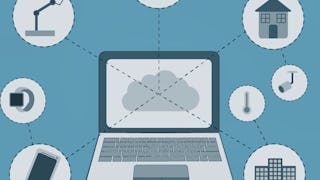This course introduces the rapidly expanding world of the Internet of Things (IoT) and embedded systems, exploring how technological trends are enabling new innovations. You'll learn about the societal impact of IoT, key design considerations, and the critical interplay between hardware and software components. We'll cover essential networking concepts to connect your devices to the Internet, preparing you for roles in IoT development and engineering. This course is for aspiring IoT developers, hardware engineers, and anyone interested in the foundational concepts of connected devices.

Enjoy unlimited growth with a year of Coursera Plus for $199 (regularly $399). Save now.

Introduction to the Internet of Things and Embedded Systems
This course is part of An Introduction to Programming the Internet of Things (IOT) Specialization

Instructor: Ian Harris
356,702 already enrolled
Included with
(13,375 reviews)
What you'll learn
Define the Internet of Things and its societal impact.
Understand embedded systems, their components, and physical world interactions.
Analyze hardware-software trade-offs in IoT device design.
Explain networking fundamentals and Internet protocols for IoT connectivity.
Skills you'll gain
Details to know

Add to your LinkedIn profile
See how employees at top companies are mastering in-demand skills

Build your subject-matter expertise
- Learn new concepts from industry experts
- Gain a foundational understanding of a subject or tool
- Develop job-relevant skills with hands-on projects
- Earn a shareable career certificate

There are 4 modules in this course
Welcome to the world of the Internet of Things (IoT)! This module will define IoT, exploring its profound impact on society and how technological trends have enabled its rapid growth. You'll understand how IoT is changing design and innovation. By the end, you'll be able to define IoT and describe its societal ramifications. To succeed, focus on understanding the core concepts as they form the foundation for future modules.
What's included
10 videos3 readings1 assignment1 peer review
Building on Module 1's IoT overview, this module delves into the design and implementation of embedded systems. You'll discover how IoT devices are 'embedded' to provide seamless functionality, interacting with the physical world through sensors and actuators. We'll discuss the structure of embedded systems and their crucial role in creating natural user interfaces. By the end, you'll understand embedded system design principles. Success Tip: Visualize how everyday objects use embedded systems to enhance their functionality.
What's included
9 videos2 readings1 assignment1 peer review
Building on our IoT foundation, this module dives into the essential hardware and software components that power IoT devices. You'll explore the roles of dedicated hardware, microcontrollers, and the software that controls them. We'll also define the function of an operating system in an IoT context. By the end, you'll understand how hardware and software interact in IoT design. Tip: Pay close attention to the microcontroller's role as it's central to embedded systems.
What's included
9 videos2 readings1 assignment1 peer review
This module explores the crucial role of networking in the Internet of Things. You'll learn how IoT devices communicate with each other and with cloud-based servers, forming larger collective systems. We'll introduce the basics of networking, focusing on Internet protocols and Mobile Ad Hoc Networks (MANETs). By the end, you'll grasp why understanding network protocols is vital for IoT device design. Success Tip: Consider how different IoT applications rely on various network types.
What's included
10 videos3 readings1 assignment1 peer review
Earn a career certificate
Add this credential to your LinkedIn profile, resume, or CV. Share it on social media and in your performance review.
Instructor

Offered by
Explore more from Software Development
 Status: Preview
Status: PreviewIIT Bombay
 Status: Preview
Status: PreviewPohang University of Science and Technology(POSTECH)
 Status: Free Trial
Status: Free TrialUniversity of California, Irvine
 Status: Free Trial
Status: Free TrialUniversity of Illinois Urbana-Champaign
Why people choose Coursera for their career




Learner reviews
13,375 reviews
- 5 stars
74.28%
- 4 stars
21.51%
- 3 stars
2.75%
- 2 stars
0.68%
- 1 star
0.76%
Showing 3 of 13375
Reviewed on Nov 26, 2017
Great class! Overall, it covers mostly the basics of Internet of Things. Good for those who are new to the field. Would not recommend it to those who have some knowledge on embedded systems already.
Reviewed on Nov 8, 2019
The course covers the basics of the Terms which are used in IoT systems and introduces you to some networking terms. Not a lot of hands-on stuff. Expecting a lot of stuff in the upcoming courses.
Reviewed on Jul 14, 2020
Please Review my Assignment!! I don't want my subscription to end!https://www.coursera.org/learn/iot/peer/qYW91/module-1-peer-review-identify-and-analyze-a-device/review/QVfqbMbxEeqwjxJtwcpIbQ
Frequently asked questions
The Internet of Things (IoT) refers to the vast network of physical devices embedded with sensors, software, and other technologies that connect and exchange data over the internet. This course will teach you the foundational concepts of IoT, its societal impact, and how it's transforming industries, making it a critical skill for future technology careers.
Embedded systems are specialized computer systems designed to perform dedicated functions within a larger mechanical or electrical system. In IoT, embedded systems are the 'brains' of smart devices, enabling them to interact with the physical world through sensors and actuators. This course will cover the design and components of these essential systems.
You will gain foundational skills in understanding IoT architecture, embedded systems design, hardware-software interaction, and basic computer networking. This includes grasping concepts like network protocols and the role of operating systems in IoT devices.
More questions
Financial aid available,
¹ Some assignments in this course are AI-graded. For these assignments, your data will be used in accordance with Coursera's Privacy Notice.





